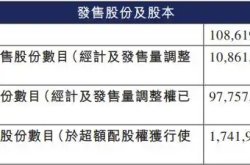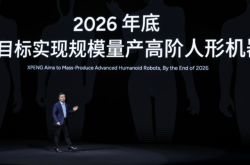XPENG Tech Day 2025: Unveiling the Next-Gen IRON Humanoid Robot
![]() 11/06 2025
11/06 2025
![]() 501
501
Produced by Zhineng Technology
The XPENG Tech Day proved to be a captivating event, especially as AI is rapidly transitioning from the digital realm into the physical world. XPENG took center stage by unveiling its cutting-edge humanoid robot, IRON.
Key highlights of this marvel include an anthropomorphic skeletal framework, a safety system powered by all-solid-state batteries, a self-developed large model tailored for the physical world, and a seamlessly integrated software-hardware architecture. The company has set its sights on mass-producing this sophisticated humanoid robot by the end of 2026.
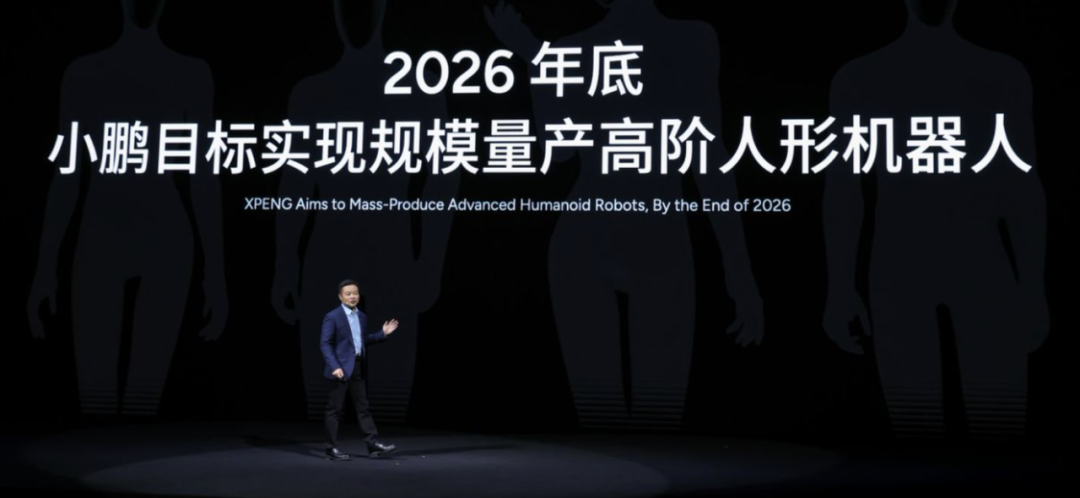
01
Anthropomorphism: Paving the Way for Physical Intelligence in Robots
In the realm of humanoid robot development, the design language plays a pivotal role in defining their positioning and the depth of their applications. The choice of 'extreme anthropomorphism' is rooted in a profound understanding of 'generalized intelligence'—only by endowing robots with a human-like physical form can their perception, interaction, and behavior models fully leverage the vast data systems of the human world. He Xiaopeng emphasized this point, stating, 'Anthropomorphism is not the ultimate goal but a necessary stepping stone towards commercialization.'

The next-generation IRON robot breaks away from the conventional 'shell assembly' design and embraces a 'born from within' bionic structure.
It boasts a comprehensive hierarchical system of 'skeleton-muscle-skin':
◎ The skeleton mirrors the curvature and stress distribution of the human spine, enabling 1:1 bionic spinal movement for seamless bending and twisting.
◎ The muscle layer, for the first time, incorporates lattice materials, providing elasticity and strength without compromising structural integrity.
◎ The flexible skin, through its seamless covering and tactile sensing capabilities, replicates the feedback characteristics of human skin. This multi-layer structure not only facilitates smoother movements but also lays the groundwork for emotional interaction.
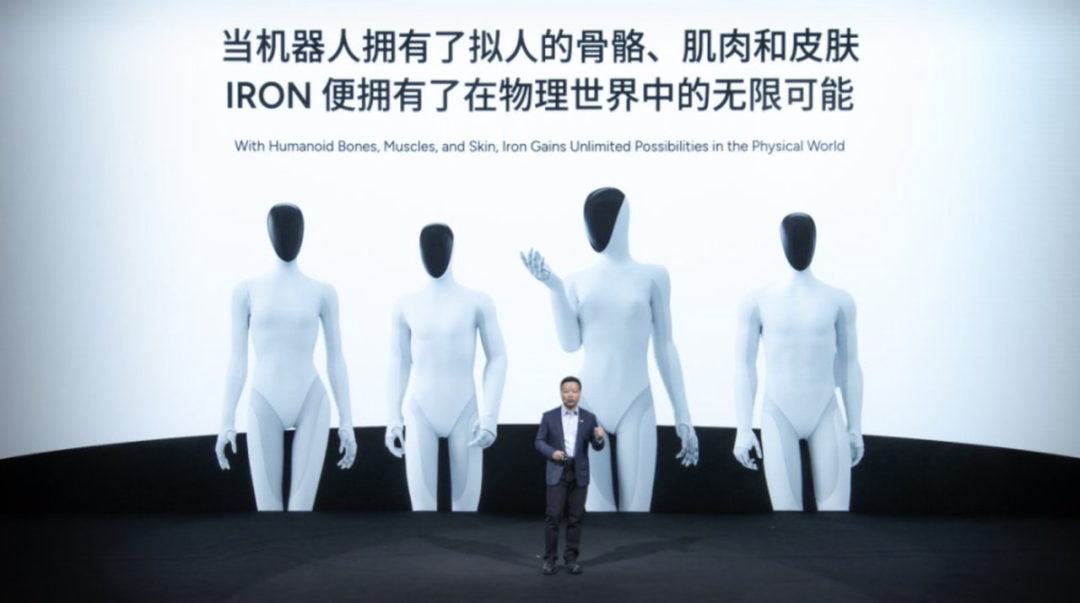
◎ IRON boasts 82 degrees of freedom. Its shoulder's degrees of freedom are achieved by repurposing the bidirectional mechanism from automotive chassis suspension, enabling human-like shoulder shrugs and chest clenches.
◎ The hands feature the industry's smallest harmonic joints, replicating human hand size and drive form with 22 degrees of freedom for precise grasping.
◎ The feet incorporate passive toe degrees of freedom, allowing for a gait that closely resembles a cat's walk—light and stable.

In terms of energy systems, IRON leads the industry by adopting all-solid-state battery technology, which reduces weight by 30% and increases energy density by the same margin. It remains stable under extreme conditions, including 250°C high temperatures and 300G impact forces, without catching fire or exploding, ensuring safe operation in complex industrial settings.
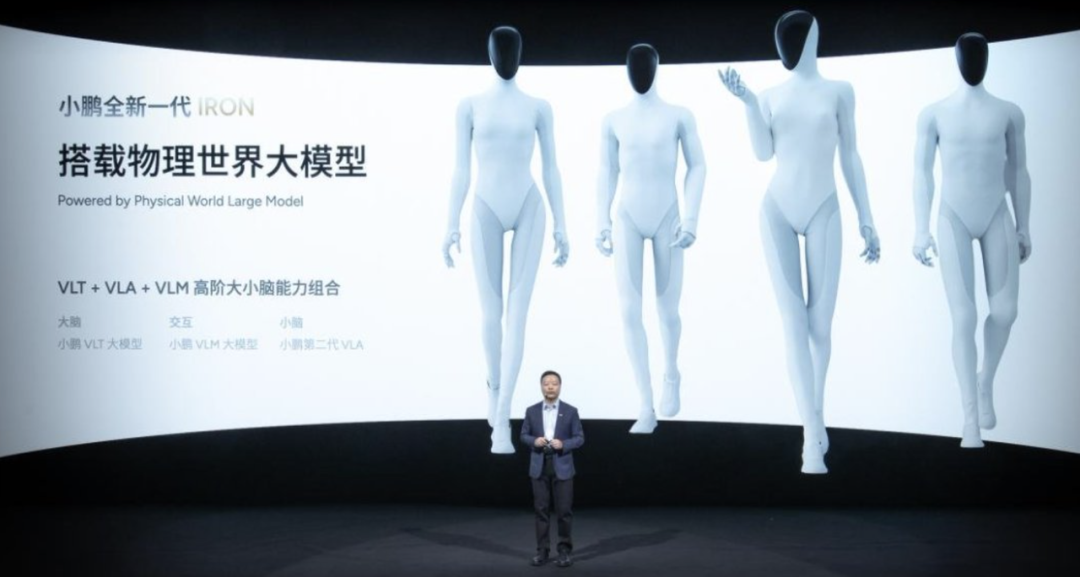
IRON achieves AI-driven physical intelligence at both the 'thinking' and 'acting' levels, thanks to its three Turing AI chips, which deliver a combined computing power of 2250 TOPS.
It is the first to integrate XPENG's self-developed 'Large Model for the Physical World,' creating a 'brain-cerebellum collaboration' architecture that includes VLT (Visual Language Transformer), VLA (Visual Language Action Model), and VLM (Visual Language Model).
Through this model, IRON enables multimodal perception, semantic reasoning, action decision-making, and real-time interaction, achieving a closed-loop behavioral logic of 'seeing, understanding, and acting correctly.' The robot possesses three advanced intelligence capabilities: 'conversation, walking, and interaction.' Embodied intelligence has transcended laboratory algorithms and is now making its mark in the dynamic physical world.

At the safety level, XPENG introduces a 'Fourth Law'—proactive safety protection—building upon the traditional 'Three Laws of Robotics.'
This means the robot not only adheres to the principle of 'not harming humans' but also calculates 'safety boundaries' in real-time within multi-objective environments to protect humans, the environment, and itself.
The introduction of this law strengthens ethical constraints on AI decision-making in physical spaces and provides an experimental model for future regulatory frameworks.
02
Full-Stack Self-Development and the Path to Industrialization
Compared to smart cars, the technical challenges of humanoid robots are exponentially more complex.
Cars are 'hardware-driven software' systems, whereas robots are 'software-driven hardware' integrations. The former emphasizes mechanical reliability and automotive-grade quality, while the latter requires real-time learning, motion coordination, and adaptive control, integrating nearly all disciplines, including vision, language, control, energy, and materials.
XPENG's strength lies in its 'full-stack self-developed physical AI system,' which encompasses a closed-loop ecosystem of algorithms, chips, operating systems, power units, and perception hardware. Smart cars and humanoid robots share approximately 70% of their technical foundations, including VLA+VLM model capabilities, AI training frameworks, and domain controller architectures.
This commonality not only reduces R&D costs but also facilitates the transfer of data and algorithms. Perception, localization, and decision-making modules from autonomous driving can be seamlessly repurposed for robot navigation and behavior prediction.
XPENG has achieved self-sufficiency in developing multiple key components.
The dexterous hands, harmonic joints, and battery packs are all independently designed, incorporating aluminum-magnesium alloy composite materials inspired by automotive manufacturing experience, reducing structural weight by 20%-30%.
By combining automotive-grade assembly processes with industrial robot precision, XPENG is constructing a robot production system capable of mass manufacturing. It has established its first 'Embodied Intelligence Data Factory' in Guangzhou, dedicated to collecting and training robot behavioral data, addressing the industry-wide challenge of 'lacking training data' and enabling AI models to continuously evolve through extensive physical interactions.
For mass production, XPENG aims to achieve large-scale production of advanced humanoid robots by the end of 2026, initially targeting commercial scenarios such as guiding, shopping assistance, and industrial inspections. The first ecological partners include Baosteel Group, where IRON will undertake complex tasks like inspections and monitoring in its factories, integrating AI with industrial manufacturing.
Baosteel's involvement is not merely a pilot application but also a validation of the robot's substitution value in high-risk, repetitive labor scenarios.

XPENG adopts an 'application-first, ecosystem co-construction' strategy.
By opening SDK interfaces, it provides global developers with API capabilities in motion control, semantic understanding, and visual recognition, fostering an open application ecosystem. This approach broadens the usage scenarios of humanoid robots while accumulating more data and algorithm feedback for XPENG, creating a positive feedback loop.
However, the challenges of large-scale production remain significant.
Humanoid robots have far higher supply chain requirements than the automotive industry. Their core joints, sensors, and control systems are still in the customized stage, with high costs and limited yields.
XPENG attempts to mitigate component shortages through vertical integration and sharing automotive supply chain resources but still needs time to accumulate production stability and certification systems.
On the other hand, the reasoning energy consumption and latency of AI large models are also technical bottlenecks limiting mass production. Reducing power consumption while ensuring real-time performance will be crucial for achieving commercial-grade operation.
XPENG's path to humanoid robot industrialization is more systematic than most competitors. Instead of focusing solely on a scientific research prototype, it adopts an integrated approach from AI algorithms, hardware systems, and scenario deployment to ecosystem construction. This logic is similar to Tesla Optimus's self-closed loop but places greater emphasis on anthropomorphism and safety in material processes and human-machine interaction experiences, while leveraging the flexibility of China's manufacturing system to lower mass production thresholds.
Summary
Over the past decade, AI has primarily existed in data and semantic spaces. Now, it is making its mark in the physical world through robots, smart cars, and unmanned systems. XPENG has chosen 'physical AI' as its strategic foundation, evolving AI's thinking, actions, and interactions in the real world.

